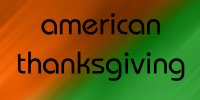New Series: The American Thanksgiving (Part 1)
 In a few short days, Americans will be celebrating Thanksgiving Day, a day that was set aside to give thanks for all the blessings we had been given by our creator. Plagerizing information from other sources, TDI will bring you the tale of the American Thanksgiving; How it was founded, what it means, and what it's evolved into today. It's not just the return of an extended series, nor is it simply a history lesson: it's a fresh understanding of how one of the most celebrated holiday's came to be. And, learning my lesson from previous series, each part will be kept pretty short.
In a few short days, Americans will be celebrating Thanksgiving Day, a day that was set aside to give thanks for all the blessings we had been given by our creator. Plagerizing information from other sources, TDI will bring you the tale of the American Thanksgiving; How it was founded, what it means, and what it's evolved into today. It's not just the return of an extended series, nor is it simply a history lesson: it's a fresh understanding of how one of the most celebrated holiday's came to be. And, learning my lesson from previous series, each part will be kept pretty short.
Part 1: A Historical Tradition
Though harvest festivals have been around for a long time, the American tradition of a Thanksgiving feast, celebrating the harvest that they got that year, didn't appear well into the colonists history.
On May 23, 1541, Francisco Vasquez de Coronado held a feast of thanksgiving, along with friendly Teya indians, in Palo Duro Canyon, Texas, to celebrate his expedition's discovery of food supplies. In 1565, in St. Augustine, Pedro Menendez de Aviles landed, and he and his men shared in a feast with the natives.
In 1578, a "harvest festival" was held in celebration by Europeans in Newfoundland by Martin Frobisher and the Frobisher Expedition. The festival was meant to give thanks for the blessings and the harvest that they had that year. There was another festival held in 1619, when 38 colonist from Berkeley Parish in England landed in Virginia and gave thanks to God.
However, the most famous Thanksgiving is remembered as taking place sometime in the autumn of 1621, when the Pilgrim colonist held a 3-day feast to celebrate their plentious harvest following their first winter in North America. They did not hold Thanksgiving again until 1623, when prayers were answered and a drought ended with rain.
In the early years of America, Thanksgivings were held sporadically. Eventually, a annual day of Thanksgiving developed in the mid-17th century, but it did not happen on any set day, nor on the same day in different colonies.
In part 2, we'll take a closer look at how Thanksgiving day developed, and what it meant to the early Americans.
In 1578, a "harvest festival" was held in celebration by Europeans in Newfoundland by Martin Frobisher and the Frobisher Expedition. The festival was meant to give thanks for the blessings and the harvest that they had that year. There was another festival held in 1619, when 38 colonist from Berkeley Parish in England landed in Virginia and gave thanks to God.
However, the most famous Thanksgiving is remembered as taking place sometime in the autumn of 1621, when the Pilgrim colonist held a 3-day feast to celebrate their plentious harvest following their first winter in North America. They did not hold Thanksgiving again until 1623, when prayers were answered and a drought ended with rain.
In the early years of America, Thanksgivings were held sporadically. Eventually, a annual day of Thanksgiving developed in the mid-17th century, but it did not happen on any set day, nor on the same day in different colonies.
In part 2, we'll take a closer look at how Thanksgiving day developed, and what it meant to the early Americans.
TDI Sources: Wikipedia

No comments:
Post a Comment